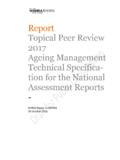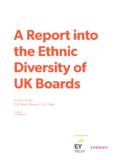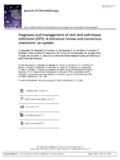Transcription of Open Access OBM Geriatrics - www.r-site.org/ageing ...
1 2017 by the author. This is an open Access article distributed under the conditions of the Creative Commons by Attribution License, which permits unrestricted use, distribution, and reproduction in any medium or format, provided the original work is correctly cited. open Access OBM Geriatrics Review The Feasibility and Necessity of a Revolution in Geriatric Medicine Giacinto Libertini 1. Italian Society for Evolutionary Biology, 14100 Asti, Italy 2. Department of Translational Medical Sciences, Federico II University, 80138 Naples, Italy; E-Mail: Academic Editor: Michael Fossel OBM Geriatrics 2017 , Volume 1, Issue 2 Received: February 20, 2017 Accepted: April 12, 2017 Published: April 17, 2017 Abstract Currently, geriatric medicine consists mainly of palliative treatment of the disorders that characterize senile decay.
2 This is perfectly compatible with the prevailing view that aging is the inevitable result of multiple degenerative processes that cannot be treated effectively as they are, in themselves, inevitable and irreversible. This interpretation of aging clashes with a mass of data and arguments that, conversely, indicate that aging is a specific physiological function, favoured by supra-individual natural selection, and is genetically determined and modulated. According to this concept, it is possible to modify, or even reverse, aging by influencing its primary mechanisms. This is diametrically opposed to the current interventions used in geriatric medicine, which act only on the effects of such mechanisms.
3 The goal of complete control of the aging process may appear Utopian; however, it is quite rational and feasible if we consider the already proven reversibility of aging at the cellular level and in some in vivo models. The method of achieving this objective by no means is to counter the countless changes that characterize aging. On the contrary, the method is to control the telomere-subtelomere-telomerase system, which appears to be the general determining factor and regulator of aging. This system can apparently be controlled by OBM Geriatrics 2017 ; 1(2), doi: Page 2/34 modifying telomerase activity, or even, as suggested recently, in combination with techniques that alter telomere and subtelomere structure.
4 In the first instance, these interventions must predominantly address the control of some manifestations of aging, such as Alzheimer s disease, Parkinson s disease and age-related macular degeneration, which are particularly devastating in terms of patient suffering and the associated economic burden. Effective treatments for these diseases represent a pivotal challenge facing a revolution in geriatric medicine, which is now both feasible and essential. The implications of such a revolution will lead to developments that will extend well beyond the boundaries of geriatric medicine. Keywords Aging; Telomere; Subtelomere; Telomerase; Alzheimer s Disease; Parkinson s Disease; Age-Related Macular Degeneration Introduction It is impossible to discuss geriatric medicine, , the prevention and care of the manifestations of senile decay, without precise scientific knowledge of the aging process.
5 First, a clear definition of aging that does not contain, clearly or covertly, pre-conceived ideas about its primary causes is indispensable. A neutral definition of aging is: increasing mortality [ , fitness decline] with increasing chronological age in populations in the wild [1], which may be well summed up as actuarial senescence [2], if the necessary specification in the wild is added. Definitions of aging include: a persistent decline in the age-specific fitness components of an organism due to internal physiological deterioration [3], progressive loss of function accompanied by decreasing fertility and increasing mortality with advancing age [4], and age-dependent decline in physiological function, demographically manifest as decreased survival and fecundity with increasing age [5].
6 These definitions are also acceptable if evident physiological degeneration is not considered a synonym of increasing mortality , as an increased death rate may also occur with a slight reduction in fitness without any evident physiological degeneration. This question is not trivial. Indeed, if, under natural conditions, rare individuals with overt physiological alterations are sought, , in a condition definable as a state of senility [6], aging will be a rarity in the wild ( aging is extremely difficult to observe in the natural habitats of most organisms [3]). In this sense, aging would be irrelevant in natural selection [4].
7 In 1957, Williams wrote: Comfort is severely critical of Weissmann s theory [who proposed that senescence was favoured by natural selection], and offers in its place the theory that senescence is selectively irrelevant. He argues ( , 1956: 39) that senescence is outside the developmental program that concerns natural selection, since almost no wild organisms ever attain the senile stage. I believe that this theory is incorrect. Its fallacy lies in the confusion of the process of senescence with the state of senility .. No one would consider a man in his thirties senile, yet according to athletic records and life tables, senescence is rampant during this decade.
8 OBM Geriatrics 2017 ; 1(2), doi: Page 3/34 [6] This is a longstanding and important error. Indeed, a recent review has documented evidence of aging, defined as increasing mortality with chronological age in populations in the wild, in 175 species [7]. Moreover, the existence of species with evident aging under natural conditions, including humans [8], has been known for a long time [1,9,10]. Thus, aging cannot be considered irrelevant in natural selection. Many theories have been proposed to explain the causes of aging [11 13]. These theories can be divided into two opposing categories of interpretations [14,15] and, in the sense proposed by Kuhn [16], are worthy of being defined as paradigms for their diversity and the importance of their implications.
9 The non-programmed aging paradigm maintains that: (i) aging is harmful to the individual and so is unlikely to be favoured by natural selection ( any hypothetical accelerated ageing gene would be disadvantageous to the individual. It is, therefore, difficult to see how genes for accelerated ageing could be maintained in stable equilibrium, as individuals in whom the genes were inactivated by mutation would enjoy a selection advantage. [4]); (ii) aging is the effect of many inevitable damaging factors that, for various reasons, natural selection may counter only partially [4]. Within this paradigm, the mechanisms of natural selection are disregarded or scarcely considered in older theories [11], while some more recent theories are based on the hypothesis that the damaging factors are insufficiently opposed by natural selection because: (i) in the wild, there are few old individuals and so natural selection against aging is weak (mutation accumulation hypothesis) [17,18]; (ii) there are genes with pleiotropic effects, , advantageous in the young and deleterious in older individuals (antagonistic pleiotropy hypothesis) [3,6].
10 And (iii) there are limits determined by other physiological necessities (disposable soma hypothesis) [19,20]. For this paradigm, aging is a useful term used only to summarize many distinct phenomena and is not a unitary phenomenon. Therefore, as this is now the prevailing paradigm, in the current international classifications of diseases (ICD9 [21] and ICD10 [22]), there is no distinct code for aging and, so, the World Health Organization cannot provide statistics for aging as a cause of death [23]. In contrast, the programmed aging paradigm maintains that aging is a physiological phenomenon, , something genetically determined and regulated that is favoured by supra-individual natural selection [15].






